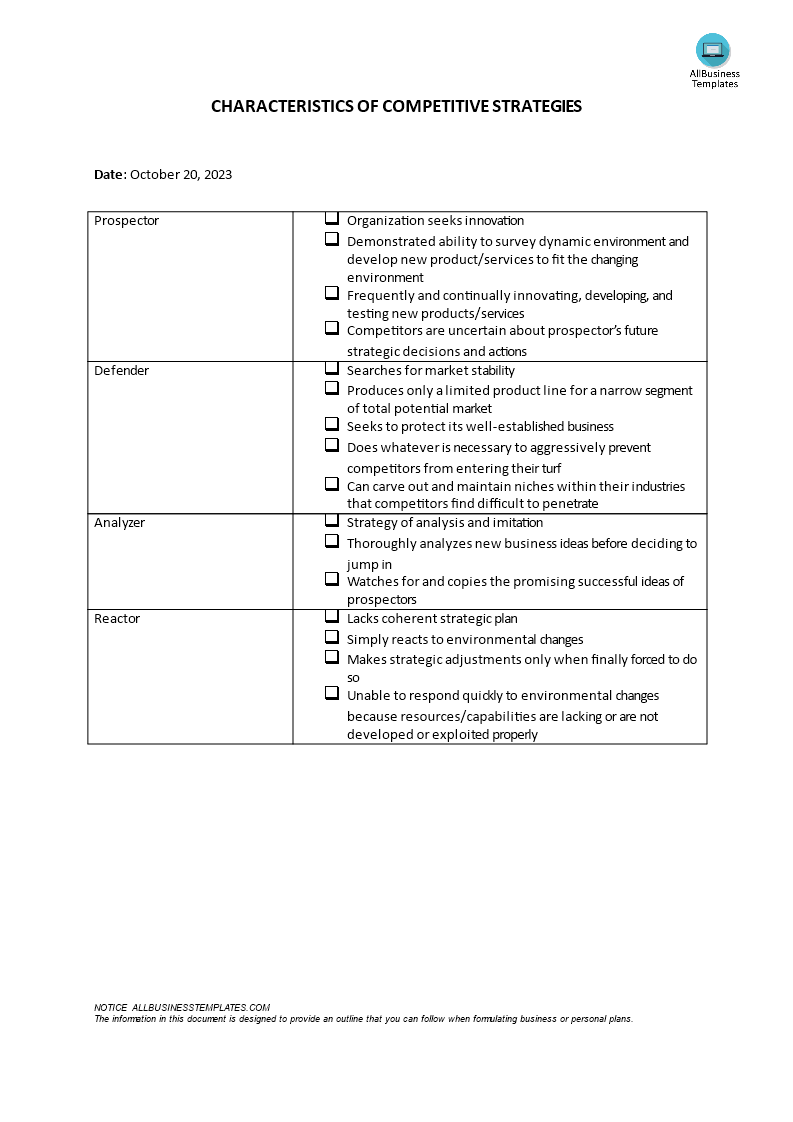Characteristics of Competitive Strategies
Save, fill-In The Blanks, Print, Done!

Download Characteristics of Competitive Strategies
Today: USD 2.99
Download It Now

Available premium file formats:
Microsoft Word (.docx)- This Document Has Been Certified by a Professional
- 100% customizable
- This is a digital download (24.6 kB)
- Language: English
- You will receive a link to download the file as soon as your payment goes through.
- We recommend downloading this file onto your computer.
How to make a competitive strategy? Do you need a Characteristics of Competitive Strategies overview? Our template contains a comprehensive overview of the key characteristics that make up a competitive strategy. We provide a detailed breakdown of the different elements, including pricing, marketing, and distribution strategies. Get our sample template now!
Competitive strategies are the approaches and plans that businesses use to gain a competitive advantage over their rivals in the marketplace. These strategies are essential for achieving business objectives, increasing market share, and ultimately achieving long-term success.
Here are some key characteristics of competitive strategies:
- Focus on Competitive Advantage: Competitive strategies are designed to create and sustain a competitive advantage. This advantage can be based on factors such as cost leadership, product differentiation, superior customer service, or innovation.
- Long-Term Orientation: Competitive strategies are not short-term tactics but rather long-term plans. They involve a sustained effort to outperform competitors over an extended period.
- Adaptation to Market Conditions: Effective competitive strategies are flexible and adaptable to changing market conditions, consumer preferences, and competitive threats. Businesses must continuously assess and adjust their strategies as needed.
- Market Positioning: Competitive strategies involve positioning a company's products or services in a way that distinguishes them from those of competitors. This positioning can target specific customer segments or market niches.
- Clear Objectives: Competitive strategies should have clear and measurable objectives. These objectives may include increasing market share, boosting profitability, expanding into new markets, or launching new products.
- Cost and Efficiency Considerations: Some competitive strategies focus on achieving cost leadership by minimizing production costs and operational inefficiencies. Cost reduction efforts can lead to competitive pricing or higher profit margins.
- Innovation and Differentiation: Others emphasize product innovation and differentiation. These strategies aim to offer unique features or benefits that set the company's products apart from competitors.
- Customer-Centric Approach: Customer needs and preferences play a central role in competitive strategies. Successful strategies often involve understanding and meeting customer demands more effectively than rivals.
- Competitor Analysis: Competitive strategies involve a thorough analysis of competitors' strengths and weaknesses. This analysis helps businesses identify opportunities to exploit rivals' vulnerabilities.
- Risk Management: Businesses must assess the risks associated with their chosen competitive strategies. Strategies that involve significant risk may also offer substantial rewards, but they require careful risk management.
- Resource Allocation: Competitive strategies often require the allocation of resources, including financial, human, and technological resources. Effective resource allocation is critical for strategy execution.
- Monitoring and Evaluation: Continuous monitoring and evaluation of competitive strategies are essential to determine their effectiveness. Metrics and key performance indicators (KPIs) are used to assess progress toward strategic goals.
- Ethical Considerations: Ethical principles and legal compliance are integral to competitive strategies. Unethical or illegal actions can harm a company's reputation and result in legal consequences.
- Global Perspective: In today's globalized economy, competitive strategies often consider opportunities and challenges in international markets. Expanding beyond domestic borders can be part of a company's strategy.
- Sustainability and Social Responsibility: Many businesses incorporate sustainability and social responsibility into their competitive strategies to address environmental and societal concerns. This can enhance their reputation and competitiveness.
Competitive strategies are dynamic and can evolve over time as market conditions change. Businesses must be agile and willing to adjust their strategies to maintain or enhance their competitive position.
Download this professional characteristic of the Competitive Strategies template now!
DISCLAIMER
Nothing on this site shall be considered legal advice and no attorney-client relationship is established.
Leave a Reply. If you have any questions or remarks, feel free to post them below.
Related templates
Latest templates
Latest topics
- Excel Templates
Where do I find templates for Excel? How do I create a template in Excel? Check these editable and printable Excel Templates and download them directly! - GDPR Compliance Templates
What do you need to become GDPR compliant? Are you looking for useful GDPR document templates to make you compliant? All these compliance documents will be available to download instantly... - Google Docs Templates
How to create documents in Google Docs? We provide Google Docs compatible template and these are the reasons why it's useful to work with Google Docs... - IT Security Standards Kit
What are IT Security Standards? Check out our collection of this newly updated IT Security Kit Standard templates, including policies, controls, processes, checklists, procedures and other documents. - Letter Format
How to format a letter? Here is a brief overview of common letter formats and templates in USA and UK and get inspirited immediately!
cheese
